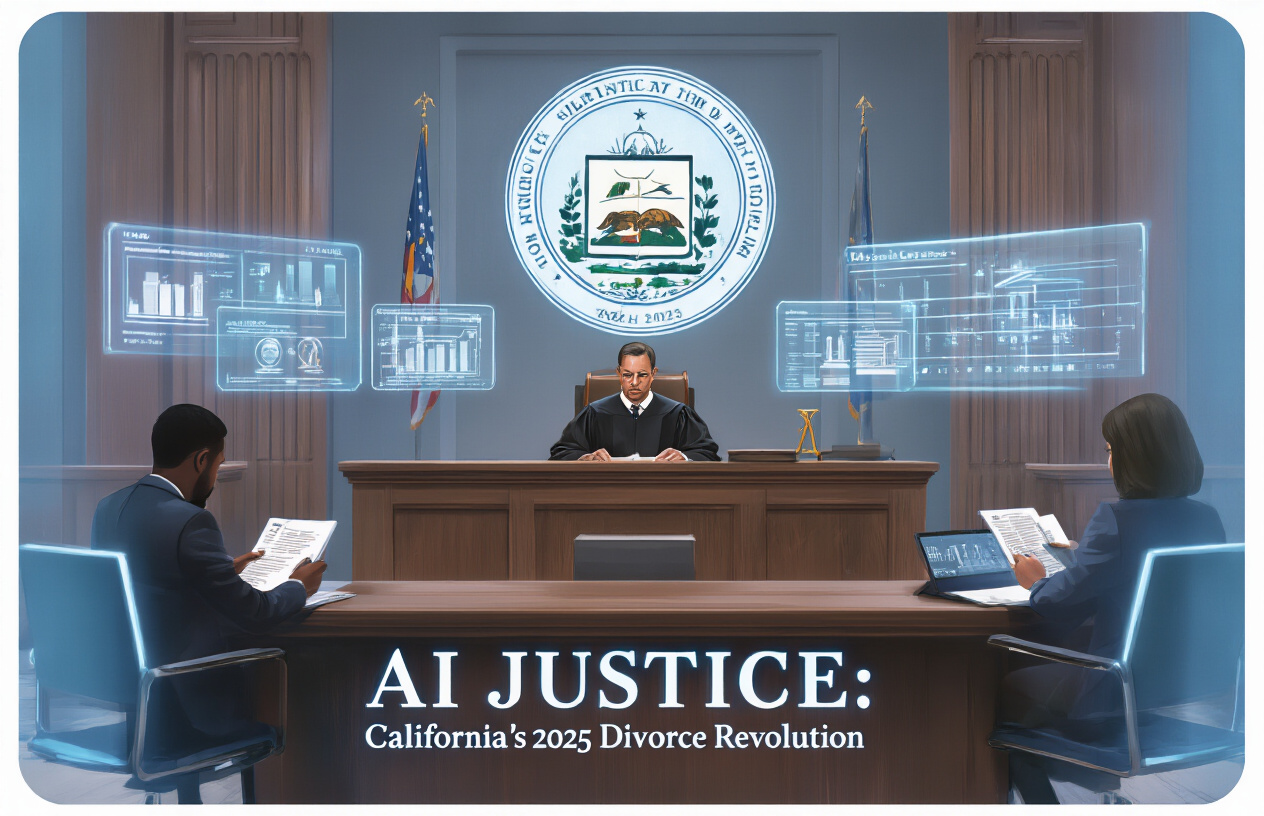
AI in the Courtroom: How California’s New 2025 Rule May Change Your Divorce Strategy
Imagine discovering that an AI predicted your divorce settlement—and got it wrong by $50,000. This isn’t science fiction; it’s happening in California courtrooms right now.
By January 2025, California’s new court rules will require attorneys to disclose when they’ve used AI in their divorce case. Whether you’re contemplating separation or already knee-deep in proceedings, this shift in AI in the courtroom could dramatically alter your divorce strategy.
The truth? Most people don’t realize how algorithms are already influencing family court decisions, from asset division to custody arrangements.
But here’s what keeps me up at night: while AI promises faster, cheaper divorces, what happens when the technology gets it wrong? And more importantly, who pays the price when it does?
Understanding California’s 2025 AI Court Rule
A. Key provisions of the new legislation
California’s 2025 AI court rule isn’t just another tech upgrade—it’s a complete reimagining of how divorce cases move through the system. The legislation requires all family courts to implement AI-powered document analysis for initial divorce filings, with mandatory authentication protocols to verify that AI-generated content is disclosed and reviewed by attorneys.
Courts must maintain human oversight for all AI recommendations, with judges required to explicitly state when they’ve relied on AI analysis in their decisions. The rule also establishes privacy safeguards that go beyond current standards, with all AI systems required to maintain CCPA-plus compliance and court-specific data protection measures.
What’s really turning heads is the provision requiring equal access. Courts must provide free AI tools for self-represented litigants—potentially leveling the playing field in a system where hiring counsel can make or break your case.
B. How AI will be integrated into courtroom procedures
The AI integration isn’t just theoretical—it’s practical and comprehensive. Starting with intake, AI will screen divorce filings for completeness and flag missing documents before cases even reach a clerk’s desk.
During discovery, AI tools will analyze financial disclosures to identify discrepancies or hidden assets—tasks that previously took accountants weeks to complete. The systems will generate standardized property division proposals based on case history and statutory guidelines.
The most controversial feature? AI-powered transcription and analysis of courtroom proceedings that flag testimony contradictions in real-time. Imagine your spouse claiming one thing in mediation and something else in court—the AI will catch it instantly.
For judges, the AI will provide case law summaries specific to the issues in your divorce, potentially standardizing outcomes across different courtrooms and counties.
C. Timeline for implementation across California courts
The rollout isn’t happening overnight. The first phase kicks off in January 2025 with seven pilot courts—Los Angeles, San Francisco, Orange County, Sacramento, San Diego, Alameda, and Santa Clara.
By July 2025, all courts serving populations over 500,000 must implement basic AI document review capabilities. Smaller courts get more time, with full statewide implementation required by December 2026.
Training for judges and court staff begins six months before their implementation date, with mandatory certification in AI ethics and system limitations. Public education campaigns about the new systems launch three months before each court’s go-live date.
The Judicial Council will conduct quarterly assessments during the first two years, with potential adjustments to implementation schedules based on effectiveness and feedback.
D. Comparison with other states’ AI legal policies
California’s approach stands out when compared to other states experimenting withCourtroomm AI:
| State | AI Implementation | Human Oversight | Public Access |
|---|---|---|---|
| California | Comprehensive across document review, case analysis, and procedural automation | Required for all decisions with detailed documentation | Free tools for self-represented litigants |
| New York | Limited to document standardization and scheduling | Case-by-case basis | Pay-to-use model |
| Texas | Pilot program for child support calculations only | Minimal requirements | Attorney-only access |
| Utah | Regulatory sandbox approach with limited oversight | Optional documentation | Varies by vendor |
While New York focuses narrowly on administrative efficiency, California’s approach prioritizes both process improvement and access to justice. Texas restricts AI to numerical calculations, avoiding the more complex aspects of family law. Utah’s experimental regulatory approach creates innovation opportunities but lacks California’s strong guardrails.
The difference? California’s rule was developed with input from both technology experts and legal aid organizations, resulting in a system that potentially serves both efficiency and equity goals.
Impact on Divorce Proceedings
AI-powered evidence analysis and its admissibility
The courts in California are about to get a whole lot smarter. Starting in 2025, AI tools will transform how evidence gets analyzed in divorce cases. Think about those text message threads with your ex that go on for miles – AI can now scan them in seconds, identifying patterns of communication and potential red flags that might otherwise take lawyers weeks to spot.
But here’s the catch – just because AI found it doesn’t mean a judge will consider it. The new rules are creating standards for the admissibility of AI-generated evidence, requiring attorneys to disclose when AI has been used to analyze or generate evidence. Courts will likely require validation that the AI systems meet specific reliability thresholds.
Predictive outcomes based on case history
Gone are the days of “your guess is as good as mine” from your divorce attorney. AI systems are now crunching data from thousands of past cases to predict how yours might unfold.
These predictive models can tell you things like:
- Likely property division outcomes based on your specific circumstances
- Probable spousal support amounts given your income disparities
- Statistical chances of winning contested issues
Some attorneys in California are already using these tools to set client expectations and develop stronger negotiation positions. The 2025 rules will standardize how these predictions can be referenced in court filings and settlement conferences.
Changes to discovery and document review processes
The discovery phase of divorce is getting a significant upgrade. AI tools now scan thousands of financial documents, emails, and text messages in hours instead of the weeks it used to take paralegals.
This means:
- Less billable hours spent on document review
- More complete discovery results with fewer human errors
- Faster identification of hidden assets or financial discrepancies
The 2025 rules establish protocols for AI-assisted discovery, including requirements for transparency about search methodologies and error rates. Parties will need to disclose the specific AI tools used during discovery and may need to provide access to opposing counsel for verification.
Financial disclosure automation and implications
Financial disclosures are notoriously tedious in California divorces. The new AI tools connect directly to financial institutions, automatically categorizing expenses, tracking income patterns, and flagging unusual transactions.
This automation creates both opportunities and challenges:
- More accurate financial pictures with less effort
- Automatic updates when financial circumstances change
- Increased scrutiny of spending patterns and financial behaviors
Under the 2025 rules, automated financial disclosures must meet specific certification standards, and both parties may have the right to audit or question the AI methodologies used. The days of fudging numbers on your disclosure forms are effectively over.
Child custody evaluation enhancements
Perhaps most significantly, AI is changing how courts approach child custody evaluations. New tools analyze communication patterns between parents, assess parental involvement through digital footprints, and even evaluate home environments through connected devices.
AI systems can now:
- Review years of communication between parents to identify cooperation levels
- Analyze children’s academic and health records for patterns related to custody arrangements
- Compare proposed custody schedules against research-backed child development models
The 2025 rules set strict ethical boundaries around AI in custody matters, requiring human oversight of all AI-generated recommendations and prohibiting certain types of predictive analyses deemed too intrusive or speculative. The child’s best interest remains the north star, but AI is providing courts with more data points to make these critical decisions.
Strategic Adaptations for Divorce Clients
A. Preparing digital footprints for AI scrutiny
The game is changing in California divorce courts. By 2025, that text you sent in anger? An AI system might flag it before you even sit down with your attorney.
Smart divorce clients are already cleaning up their digital acts. This isn’t about hiding evidence (that’s illegal), but about being mindful that AI tools can dig deeper and faster than any human paralegal ever could.
Start by auditing your social media. Those vacation photos with expensive champagne might contradict your financial disclosures. The late-night rants about your ex? They paint a picture of your character that AI will spot in seconds.
Your digital communications need the same scrutiny. Email threads, text messages, even your Google search history could become fair game with advanced AI tools. California’s new rules don’t just change how lawyers work—they fundamentally alter what’s practically discoverable in your case.
B. Leveraging AI tools for case preparation
The flipside? You can use similar tools to strengthen your position.
AI-powered document analysis can help identify patterns in financial records that human eyes might miss. That retirement account that’s been slowly depleted? AI can track those transactions and create compelling visual evidence.
Several consumer-grade AI tools can help organize your evidence before you even meet with your attorney, potentially saving thousands in legal fees:
- Document classification systems to organize financial records
- Sentiment analysis on communication history to identify key turning points
- Predictive models that estimate potential settlement ranges based on case factors
C. Privacy considerations in an AI-enhanced courtroom
The privacy implications are massive. California’s 2025 rule doesn’t just change technical procedures—it transforms what parts of your life become visible during divorce proceedings.
Court-approved AI systems will likely have access to unprecedented amounts of data. This means your attorney needs to file appropriate motions to protect sensitive information that isn’t relevant to your case.
Some smart precautions include:
- Requesting specific limitations on AI analysis scope
- Demanding transparency about what algorithms are being used
- Seeking expert testimony when AI-generated conclusions seem questionable
- Creating detailed logs of what automated systems have processed personal data
Your right to privacy doesn’t disappear in divorce court, but protecting it requires new strategies when AI enters the picture.
Benefits and Risks of AI in Divorce Cases
Potential for faster, more affordable proceedings
The clock is ticking in divorce cases, and so is the money meter. Traditional divorces can drag on for months—sometimes years—burning through savings faster than a California wildfire.
AI is changing this game completely. Think of an automated document review that takes hours instead of weeks. Forms that practically fill themselves out. Scheduling that happens with a few clicks instead of endless phone tag.
Some California courts are already testing AI systems that can:
- Process standard motions without human review
- Auto-generate common legal documents
- Predict case timelines with surprising accuracy
A divorce that once took 18 months might wrap up in 5. What used to cost $20,000 could drop to $7,000. That’s not just convenience—it’s life-changing for people who couldn’t afford proper legal help before.
Concerns about algorithmic bias in decisions
The flip side? AI doesn’t understand human nuance. The systems being developed for 2025 will make recommendations based on past cases—cases decided in a system that wasn’t always fair to everyone.
Women, minorities, and lower-income individuals have historically received uneven treatment in family courts. When AI learns from these precedents, it risks cementing these biases into code.
Consider custody decisions. If past judges favored traditional family structures, AI might perpetuate these preferences regardless of what’s best for specific children.
The real danger isn’t just that AI might be biased—it’s that we’ll assume it’s neutral because “computers don’t discriminate.” But computers inherit human biases through their training data.
Enhanced accuracy in asset valuation and division
Money talks in divorce cases, and AI is becoming fluent in that language. The 2025 rules will likely standardize AI tools that can:
- Automatically track down hidden assets across digital platforms
- Value complex investments without expensive specialists
- Predict the future value of retirement accounts and real estate
- Compare settlement offers against thousands of similar cases
This means no more “I forgot about that account” or vastly undervalued businesses. AI doesn’t miss cryptocurrency wallets or offshore accounts that human lawyers might overlook.
For middle-class couples with moderately complex finances, this could mean thousands more in fair settlements. For high-net-worth divorces, we’re talking potential millions in previously overlooked assets.
Reduced emotional burden through automation
Divorce isn’t just financially draining—it’s emotionally exhausting. The constant back-and-forth, repeating painful details, and navigating hostile negotiations take a massive psychological toll.
AI tools coming in 2025 will handle the most repetitive and triggering aspects:
- Automated communications that filter hostile language
- Chat interfaces for providing sensitive information without face-to-face confrontation
- Negotiation platforms that find compromise without direct conflict
Many divorcing couples report that these technologies let them focus on healing rather than fighting. When AI handles the paperwork, humans can handle their emotions.
But this emotional buffer comes with trade-offs. Some cases need human empathy that AI can’t provide. A good mediator reads body language and understands unspoken concerns in ways algorithms can’t match.
Working with Legal Counsel in the AI Era
Finding attorneys with AI litigation expertise
The AI wave is hitting courtrooms, and not all lawyers are ready to surf it. Some attorneys are still using legal pads while others have AI analyzing case law before breakfast.
When searching for a divorce attorney in California, look beyond the usual credentials. Ask about their experience with AI tools in litigation. Have they used predictive analytics for case outcomes? Do they understand how judges in your county respond to AI-generated evidence?
The best attorneys aren’t necessarily the tech gurus, but they should understand how AI affects your specific situation. Find someone who balances traditional legal expertise with technological awareness.
Check bar association technology committees and legal tech conferences for attorneys actively engaging with these changes. Many forward-thinking firms now highlight their AI capabilities on their websites.
Questions to ask your divorce lawyer about AI readiness
When interviewing potential attorneys, get specific:
- “How are you preparing for the 2025 AI court rules?”
- “What AI tools does your firm currently use for divorce cases?”
- “Have you handled cases where the opposing party used AI tools?”
- “How might AI affect my specific custody or property division issues?”
- “Can you explain how you verify AI-generated information?”
Don’t settle for vague answers like “we’re tech-savvy.” Dig deeper. A reasonable attorney will explain real applications, not just buzzwords.
Cost implications of AI-assisted legal services
The money question: Will AI make your divorce cheaper or more expensive?
In the short term, expect some firms to charge premium rates for AI capabilities. The technology investment is substantial, and early adopters are passing costs to clients. However, routine tasks like document review and fundamental discovery can become dramatically cheaper.
Many firms now offer tiered service models:
| Service Level | AI Integration | Approximate Cost Impact |
|---|---|---|
| Basic | AI-assisted document review | 15-20% savings |
| Standard | Predictive analytics + document review | 5-10% savings |
| Premium | Full AI integration with attorney oversight | May cost 10-15% more |
The real savings often come from faster resolutions and better-prepared cases, not just hourly rate reductions.
Collaborative approaches enabled by new technology
AI is reshaping collaborative divorce in fascinating ways. Online platforms now help couples visualize different property division scenarios instantly, taking emotion out of financial decisions.
Co-parenting apps with AI features can suggest compromise solutions based on similar cases. Some mediators use anonymized data from thousands of settlements to suggest fair outcomes.
The technology works best when both parties commit to transparency. Your attorney should help you understand when sharing data benefits you and when traditional protective strategies make more sense.
The most effective lawyers aren’t just using AI tools—they’re helping clients understand when technology serves their interests and when human judgment should prevail.
The Shifting Legal Landscape
California’s 2025 AI court rule represents a significant shift in how divorce cases will be handled in the near future. As AI tools become integrated into courtroom procedures, divorce clients must adapt their strategies accordingly. Understanding the potential impacts on evidence presentation, case management, and judicial decision-making will be crucial for those navigating divorce proceedings in this new technological era.
The implementation of AI in California courts offers both promising benefits and concerning risks. While these tools may streamline processes and potentially reduce costs, they also raise important questions about privacy, data security, and algorithmic bias. As this transformation unfolds, working closely with legal counsel who understands both divorce law and emerging AI technologies will be essential. Attorneys who can effectively navigate this intersection of technology and family law will provide invaluable guidance to clients seeking favorable outcomes in their divorce cases under California’s new AI framework.
At Lass Law, our Divorce & Family Law Attorneys in North County San Diego are dedicated to protecting your family’s future. From working with a Family Law Attorney in Encinitas to resolving disputes with a trusted Divorce Law professional, we provide clear strategies and advocacy. Clients also turn to us for guidance from a Family Law Attorney in San Marcos or when comprehensive Family Law representation is needed.










